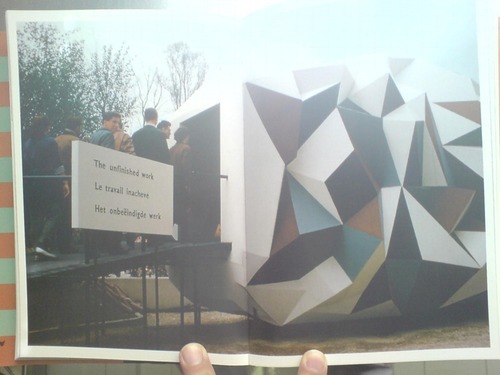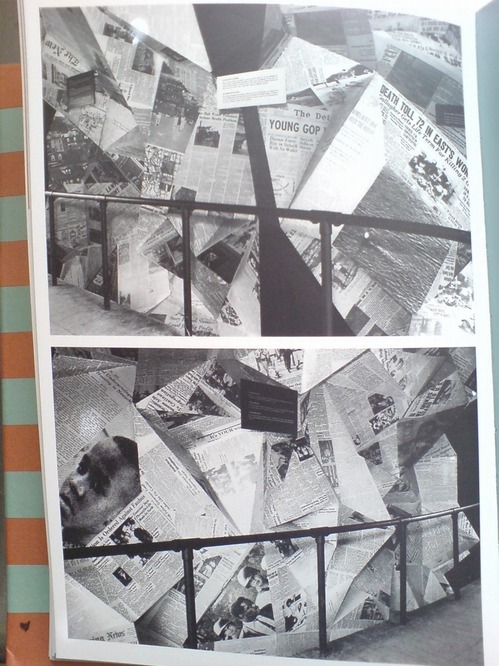
In the early Cold War of the mid-1950s, the Soviet Union countered American condemnation of its repressive actions in East Germany and Hungary with criticism of the US’s internal policies of segregation and racial discrimination. Planners of the US Pavilion at the 1958 World Expo in Brussels, the first since before WWII, warned that “the desegregation issue would be ‘underlined rather than evaded by omission.'” As longtime USIA design director Jack Masey put it in his 2008 book, Cold War Confrontations, “The Unfinished Business” Pavilion was created by Fortune magazine and/for the State Department “as a way to save face–openly and directly–[by anticipating] negative Soviet propaganda about domestic problems in the US.”
Fortune art director Leo Lionni designed both the pavilions and the exhibit as three distinct sections: past, present and future. The form of each pavilion mirrored the content of its exhibit, though none were so programmatically matched as the first pavilion, where the darkly colored “chaotic crystal” of the exterior [below]

was wallpapered inside with a jumbled, kaleidoscopic collage of US newspapers. Headlines related to desegregation battles were interspersed among other front page stories, presumably to dilute the racism issue by expanding the context, and to underscore the country’s uncensored media as a site of free debate and progress.

The second, present pavilion had some quotes from President Eisenhower and other leaders, whatever, but it was the bright future pavilion that turned out to be the most incendiary. For its expansive, smooth walls featured large photomurals of amber waves of grain, and a group of happy, young children–“white, colored, and yellow”–playing in a flower-filled meadow.

Which basically made segregationist politicians from the South’s heads explode when they found out about it. Masey gives an overview of the controversy in his book, including some declassified letters from outraged Dixiecrats to Eisenhower’s acting Secretary of State. But Michael Krenns devotes an entire chapter to the political shitstorm surrounding the “Unfinished Business” pavilion in his 1999 history anthology, The Impact of Race on US Foreign Policy: A Reader. Great stuff.
Throughout the Spring and Summer of 1958, angry congressmen criticized the exhibit for “foul[ing] the nation’s nest.” The pavilion was temporarily shut down–the official explanation was “poor craftmanship” on the part of the “Belgian carpenters” who somehow failed to properly execute Lionni’s original concept. By including too many news clippings about Little Rock and Gov. Faubus. Leonni hustled to Brussels to make ordered changes to bring “balance” to the desegregation issue.
They even posted a disclaimer that children of various races playing together “did not represent US policy, but was representative of the freedom of choice available in the US.” And still Georgia’s segregationist senator Herman Talmadge protested, demanding an end to exhibition’s “unwarranted invasion of the rights and prerogatives of the states of the South.”
Faced with calls for a congressional investigation that could turn “The Unfinished Business” into The Neverending Business, the Eisenhower administration caved, and by mid-summer, the State Department shut down what the European press had called “the most effective propaganda in the American Pavilion” and replaced it with an exhibit about the unfinished business of public health.
Skip to content
the making of, by greg allen
